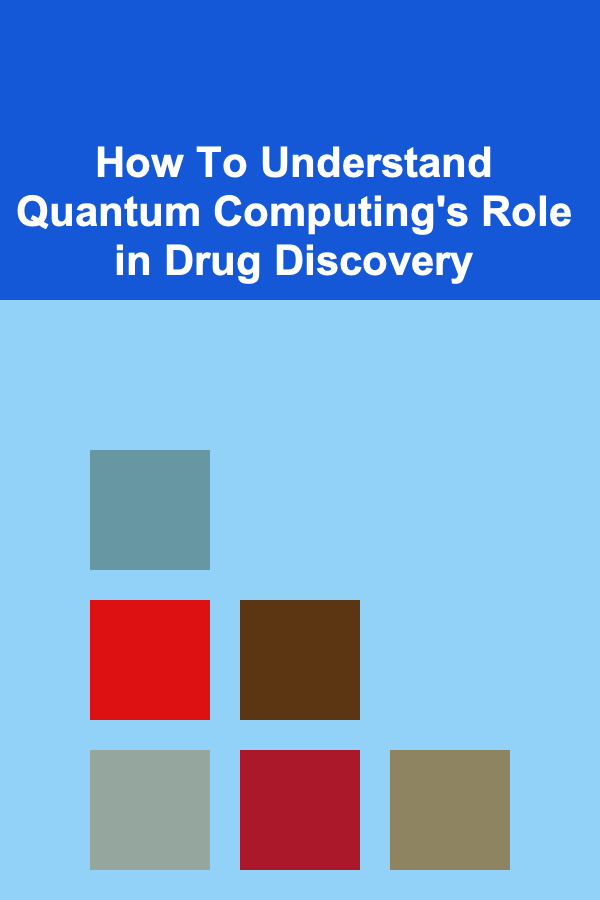
How To Understand Quantum Computing's Role in Drug Discovery
ebook include PDF & Audio bundle (Micro Guide)
$12.99$7.99
Limited Time Offer! Order within the next:

The field of drug discovery has been a critical focus in the health and life sciences sectors for decades, with the ultimate goal of developing new and effective treatments for a wide range of diseases. However, traditional drug discovery methods, while groundbreaking, face certain limitations, especially as the complexity of biological systems continues to evolve. One of the most exciting frontiers in modern science is the intersection between quantum computing and drug discovery, which holds the potential to revolutionize the process of discovering new drugs.
Quantum computing is a relatively new and highly specialized area of study that utilizes principles from quantum mechanics to solve complex computational problems that would be intractable for classical computers. In the context of drug discovery, quantum computing offers unique advantages by simulating molecular structures and interactions at an atomic level, which is an inherently quantum process. By leveraging these quantum properties, researchers can significantly speed up drug discovery, improve accuracy, and overcome challenges that have hindered the field for decades.
This article delves into the role of quantum computing in drug discovery, examining how it works, its potential advantages, challenges, and its implications for the future of healthcare.
Quantum Computing Basics
Before we explore how quantum computing influences drug discovery, it is essential to understand what quantum computing is and how it differs from classical computing.
Classical Computing vs. Quantum Computing
Classical computers, which most people use daily, process information as binary code: zeros and ones. These bits of information are processed in a linear fashion, meaning that for complex calculations, the computer must follow a series of steps that, while efficient, may take a long time to solve large or intricate problems. The computational power of classical computers is often limited by the number of transistors they can use, which defines how fast and accurately they can perform operations.
In contrast, quantum computers use quantum bits or qubits to process information. Qubits, unlike classical bits, can represent both 0 and 1 simultaneously due to a phenomenon known as superposition . This enables quantum computers to perform parallel computations at an exponentially higher rate than classical computers. Furthermore, quantum computers take advantage of another quantum mechanical principle called entanglement, where qubits can be correlated in such a way that the state of one qubit can instantaneously affect the state of another, regardless of distance.
These quantum properties allow quantum computers to perform certain calculations much more efficiently than classical systems, making them highly suitable for solving problems in fields like cryptography, optimization, machine learning, and, as we will see, drug discovery.
Quantum Computing and Molecular Simulation
The behavior of molecules and their interactions is governed by the laws of quantum mechanics. At the atomic and subatomic level, particles do not behave in a deterministic way but instead follow probabilistic rules. Classical computers, with their binary nature, have a hard time simulating the quantum behavior of molecules in a realistic way. In drug discovery, simulating the behavior of molecules is essential because the goal is to design and test new drugs by observing how they interact with biological systems.
Quantum computers, by contrast, are uniquely suited to simulate quantum mechanical systems. They can model atomic interactions and molecular dynamics with much greater accuracy and speed, allowing researchers to predict how different compounds will interact with proteins, enzymes, and other cellular structures. This ability to simulate molecular behavior opens up new possibilities in drug discovery, including more accurate predictions of drug efficacy, toxicity, and side effects.
The Role of Quantum Computing in Drug Discovery
Speeding Up Drug Discovery
The process of discovering new drugs typically involves several stages, including the identification of potential drug targets (often proteins or other molecules), high-throughput screening of thousands or millions of compounds, and testing for efficacy, toxicity, and side effects. This process can take years, and the vast majority of compounds that are tested fail to produce effective results.
One of the key ways that quantum computing can accelerate drug discovery is by significantly speeding up the simulation and testing stages. Traditional methods of simulating molecular behavior are time-consuming and resource-intensive. Quantum computers can model molecular interactions in a fraction of the time, allowing researchers to explore a wider variety of compounds more quickly and accurately. This can lead to faster identification of promising drug candidates, which is particularly important when dealing with emerging diseases or pandemics.
For instance, during the COVID-19 pandemic, researchers were tasked with identifying potential treatments for the virus. Classical computer simulations took weeks or even months to analyze certain molecular interactions. With quantum computers, researchers can simulate these interactions in a matter of days, thus accelerating the process of finding viable drug candidates.
Enhanced Drug Design
Another significant advantage of quantum computing in drug discovery is the ability to improve the design of drugs themselves. Traditional drug design often relies on a trial-and-error approach, where researchers modify the chemical structure of a compound and test its effect on biological systems. This process can be slow and costly, as it often requires extensive laboratory testing and animal studies.
Quantum computing allows for more precise molecular modeling, enabling researchers to design drugs with a higher degree of accuracy. By simulating the interactions between drug molecules and their biological targets, quantum computers can predict how modifications to a drug's chemical structure will affect its performance. This predictive capability can lead to the design of more effective and specific drugs, potentially reducing the number of iterations required in the drug development process.
Moreover, quantum computing can help to identify compounds that are likely to bind to specific receptors or enzymes, which is a key part of the drug design process. By simulating these binding interactions at a molecular level, researchers can better understand how drugs will interact with biological systems, allowing for the design of drugs that are more selective and less likely to cause adverse side effects.
Addressing Drug Resistance
Drug resistance is one of the most significant challenges in modern medicine, particularly in the treatment of infections and cancer. Over time, pathogens and cancer cells can evolve to become resistant to existing drugs, making it more difficult to treat diseases effectively. Quantum computing offers a potential solution to this problem by enabling researchers to understand the molecular mechanisms behind drug resistance in greater detail.
By simulating the behavior of molecules involved in drug resistance, quantum computers can help to identify new drug targets or drug combinations that might be effective against resistant strains. For example, researchers may be able to simulate how a pathogen's genetic mutations affect its ability to bind to a drug, enabling them to design drugs that can overcome this resistance.
Furthermore, quantum computing could help in designing drugs that are less likely to lead to resistance in the first place. By understanding the dynamics of drug-target interactions at a quantum level, researchers can design drugs that are more effective in the long term, reducing the likelihood of resistance developing.
Personalized Medicine
Personalized medicine is an approach that tailors medical treatments to individual patients based on their genetic makeup, lifestyle, and other factors. This approach has the potential to improve the effectiveness of treatments and minimize side effects, but it requires an in-depth understanding of how individual variations in genetics affect drug responses.
Quantum computing could play a key role in personalized medicine by enabling more detailed simulations of how a patient's unique genetic profile influences drug efficacy. For example, quantum computers could model how specific mutations in a patient's DNA affect the way their cells respond to a drug, allowing doctors to select the most effective treatment for each individual.
Additionally, quantum computing could help to optimize drug formulations for different patient populations. By simulating how a drug interacts with various genetic variations, researchers can design drugs that are more universally effective or that work better for specific subgroups of patients.
Overcoming the Limitations of Classical Computing
Classical computers struggle with certain types of calculations, particularly when it comes to simulating the behavior of complex molecular systems. The number of variables involved in these simulations can quickly grow to the point where classical computers become overwhelmed. Quantum computing, with its ability to perform parallel computations and handle large datasets, has the potential to overcome these limitations.
In drug discovery, this could mean that quantum computers are able to simulate large, complex molecules that are beyond the reach of classical computers. For example, quantum computing could be used to simulate large proteins or enzyme complexes that play a crucial role in disease development, helping researchers understand how drugs interact with these complex molecules in ways that were previously impossible.
Quantum Machine Learning in Drug Discovery
Quantum machine learning (QML) is a rapidly emerging field that combines the power of quantum computing with machine learning techniques. In drug discovery, QML can be used to analyze vast datasets and identify patterns that might be difficult for classical algorithms to detect. This could involve identifying new drug targets, predicting the toxicity of drugs, or optimizing the drug design process.
By leveraging quantum computing, researchers can process large amounts of data more efficiently, allowing for the development of more accurate predictive models. These models could be used to predict how different compounds will interact with biological systems, enabling researchers to identify promising drug candidates more quickly.
Challenges and Future Outlook
While quantum computing holds great promise for drug discovery, there are still several challenges that need to be overcome before it can be widely implemented in the field. One of the biggest challenges is the current state of quantum hardware. Quantum computers are still in the early stages of development, and many of the systems available today are prone to errors and require highly controlled environments to function properly.
Additionally, the software and algorithms used to harness the power of quantum computers are still being refined. It will take time to develop algorithms that can fully leverage quantum computing's capabilities for drug discovery, and much of the research in this area is still in its infancy.
Despite these challenges, the future of quantum computing in drug discovery is incredibly promising. As quantum hardware improves and more advanced algorithms are developed, quantum computing is likely to play an increasingly important role in accelerating the drug discovery process. In the coming years, we can expect to see breakthroughs in drug design, personalized medicine, and disease treatment, driven by the power of quantum computing.
Conclusion
Quantum computing has the potential to transform drug discovery by enabling more accurate simulations of molecular behavior, accelerating the design of new drugs, and overcoming the limitations of classical computing. While there are still significant challenges to overcome, the promise of quantum computing in drug discovery is undeniable. As the technology continues to evolve, it may help unlock new treatments for a wide range of diseases, offering hope for more effective and personalized therapies in the future.

How to Choose the Right Furniture for Easy Organization
Read More
How to Identify Your Target Market
Read More
How to Plan a Holiday Decorating Party with Friends
Read More
How to Start Writing Part-Time from Home: A Creative Writer's Guide
Read More
How To Learn to Write Melodies for Your Songs
Read MoreHow to Integrate Your Home Maintenance Tracker with Budgeting Apps
Read MoreOther Products

How to Choose the Right Furniture for Easy Organization
Read More
How to Identify Your Target Market
Read More
How to Plan a Holiday Decorating Party with Friends
Read More
How to Start Writing Part-Time from Home: A Creative Writer's Guide
Read More